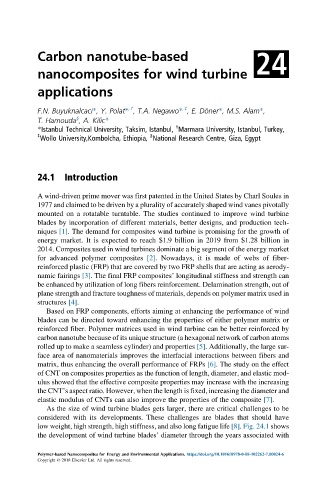Page 690 - Polymer-based Nanocomposites for Energy and Environmental Applications
P. 690
Carbon nanotube-based 24
nanocomposites for wind turbine
applications
,‡
,†
F.N. Buyuknalcaci*, Y. Polat* , T.A. Negawo* ,E.D€ oner*, M.S. Alam*,
§
T. Hamouda , A. Kilic*
†
*Istanbul Technical University, Taksim, Istanbul, Marmara University, Istanbul, Turkey,
‡ §
Wollo University,Kombolcha, Ethiopia, National Research Centre, Giza, Egypt
24.1 Introduction
A wind-driven prime mover was first patented in the United States by Charl Soules in
1977 and claimed to be driven by a plurality of accurately shaped wind vanes pivotally
mounted on a rotatable turntable. The studies continued to improve wind turbine
blades by incorporation of different materials, better designs, and production tech-
niques [1]. The demand for composites wind turbine is promising for the growth of
energy market. It is expected to reach $1.9 billion in 2019 from $1.28 billion in
2014. Composites used in wind turbines dominate a big segment of the energy market
for advanced polymer composites [2]. Nowadays, it is made of webs of fiber-
reinforced plastic (FRP) that are covered by two FRP shells that are acting as aerody-
namic fairings [3]. The final FRP composites’ longitudinal stiffness and strength can
be enhanced by utilization of long fibers reinforcement. Delamination strength, out of
plane strength and fracture toughness of materials, depends on polymer matrix used in
structures [4].
Based on FRP components, efforts aiming at enhancing the performance of wind
blades can be directed toward enhancing the properties of either polymer matrix or
reinforced fiber. Polymer matrices used in wind turbine can be better reinforced by
carbon nanotube because of its unique structure (a hexagonal network of carbon atoms
rolled up to make a seamless cylinder) and properties [5]. Additionally, the large sur-
face area of nanomaterials improves the interfacial interactions between fibers and
matrix, thus enhancing the overall performance of FRPs [6]. The study on the effect
of CNT on composites properties as the function of length, diameter, and elastic mod-
ulus showed that the effective composite properties may increase with the increasing
the CNT’s aspect ratio. However, when the length is fixed, increasing the diameter and
elastic modulus of CNTs can also improve the properties of the composite [7].
As the size of wind turbine blades gets larger, there are critical challenges to be
considered with its developments. These challenges are blades that should have
low weight, high strength, high stiffness, and also long fatigue life [8]. Fig. 24.1 shows
the development of wind turbine blades’ diameter through the years associated with
Polymer-based Nanocomposites for Energy and Environmental Applications. https://doi.org/10.1016/B978-0-08-102262-7.00024-6
Copyright © 2018 Elsevier Ltd. All rights reserved.

